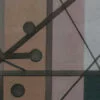Golda Meir visited Iran as Israeli Foreign Minister in July 1965. Her unmarked aeroplane landed in the darkness before dawn at Mehrabad Airport, and she was ushered to a special guest house in northern Tehran. Meir’s advisers were keen to publicise her visit but the Iranians insisted on keeping it secret. The secrecy provided the Shah with cover during a moment of upheaval in the world of oil: Iran was expected to present a united front with Arab states in their negotiations with the Seven Sisters, the European and American oil companies that controlled the majority of global production.
At the time, the Seven Sisters were reluctant to openly sell oil to Israel, lest they anger the increasingly assertive Arab states. Given that a spot market in oil was only to emerge more than a decade later, Israel was determined to find a reliable supplier of crude. Meir spoke directly to the Shah. She suggested a joint venture between Iran and Israel whereby Iranian oil, shipped on tankers to the sleepy port city of Eilat on the Gulf of Aqaba, would slake Israel’s energy needs. Eilat would be one terminus of a large-diameter pipeline, covertly constructed to traverse Israel from the Red Sea to Ashkelon on the Mediterranean. Trucks, smaller tankships, and narrower pipelines would then carry the oil internally to the refinery in Haifa. 1 What would be of interest to the Shah was the excess petroleum, shipped on Israeli tankers to markets in Europe. Meir had already visited Romania and secured an agreement from Bucharest to purchase this excess Iranian oil.
The Shah was non-committal about the pipeline suggestion at first, but things changed with the closure of the Suez Canal in the 1967 war two years later. The crisis gave Iran the impetus it needed for the provision of oil to Israel and sale of oil to European customers through Israel. It would corner a comparative advantage against its Arab rivals by the lower carriage costs that came from not having to transport the oil around the Cape of Good Hope. Iran commissioned a feasibility study. The men in charge were National Iranian Oil Company’s Fathollah Naficy and Felix Shinar, who had just concluded his tenure as the head of the Israeli reparations mission to Cologne. In 1968, the two countries incorporated a joint-venture company named Trans-Asiatic in Switzerland and bought the infrastructures of an already existing smaller pipeline between Eilat and Be’er Sheva from the Rothschild Group. Trans-Asiatic also ordered tankers to transport the oil by sea. Hermann Abs of Deutsche Bank met with Shinar and Naficy in Switzerland to hash out the financing for the larger pipeline, with the West German government guaranteeing a more generous interest rate than loans on open markets. Abs had been one of the most powerful bankers to the Third Reich and, as the head of Deutsche Bank’s foreign department, had been responsible for the expropriation of European Jewish assets and the looting of European banks in occupied areas. After the war, Abs was sent to unstitch his earlier handiwork: he was put in charge of the German restitution to Israel and in that capacity had developed a cordial working relationship with Shinar.
The Eilat–Ashkelon pipeline went into operation in 1969, on the eve of the nationalisation of oil. The loosening of the grip of the Seven Sisters, and the coming Arab–Israeli War in 1973 opened up a space for independent traders to make deals with buyers and producers. The problem was how to get the oil from the Gulf to its buyers in Europe and the Americas while the Suez Canal was closed. As Iran did not want to be seen to be trading directly with Israel or shipping its oil through Israel to European customers, middlemen were needed.
Enter Marc Rich, a Belgian-American commodities trader who foresaw the seismic transformation of the oil market and decided to take advantage. Rich’s American business partner Pincus Green, who had inked major metals contracts with Iran and spoke Persian, introduced Rich to Iranian oil men. Rich began to cultivate a relationship with the oil technocrats, and with the Shah himself, who took his skiing holidays in St Moritz, where Rich owned a chalet on the Suvretta slope. Rich managed to sign a long-term oil contract with Iran that secured his company Iranian crude at $5 per barrel for the duration of the deal, just as the price of oil was about to skyrocket from $3 to $11.50 a barrel. Rich then sought buyers who were not already in hock to the majors.
Since the Suez Canal was still closed, Rich began negotiating independently with the Israeli government. The French bank Paribas financed Rich’s large shipments of oil from Iran. The tankers unloaded their cargo at Eilat, with some of the oil making its way to the Haifa and, later, Ashdod refineries. Rich’s ships collected the excess at Ashkelon and transferred the cargo directly to US and European buyers. Refineries, petrochemical industries, power plants, and governments made excellent customers for the Marc Rich + Co trade in oil. Rich even bought substantial shipments of Iranian oil for the United States Defence Fuel Supply Center and shipped it through the Eilat–Ashkelon pipeline. In some years Rich sold more oil than some producing nations. Many years later, Rich told his biographer, Daniel Ammann, that the pipeline had given him ‘a big price advantage. The transport of Iranian crude through the pipeline was much cheaper than going all the way around Africa’. Marc Rich became fabulously wealthy from the stealth trade through the Eilat–Ashkelon pipeline. The deal also benefited Iran, whose oil was now more attractive to Europeans because of its lower freight markup; and Israel met its energy needs and bolstered its foreign reserves.
Rich courted Iran even after the revolution that toppled the Shah. While the deals between the National Iranian Oil Company and the majors fell apart in 1979, it continued to honour its deals with Marc Rich, selling him around 70 million barrels of oil per year, a good deal of which made its way to the oil terminal at Eilat. In the twenty years he helmed his trading company, Rich sold Israel up to 20 per cent of its annual oil needs. Revolutionary leaders in Iran were content with symbolic gestures of enmity against the ‘Little Satan’, but never weaponised the oil trade with Israel.
Rich’s lack of scruples in dealing with revolutionary Iran irritated chauvinists in the United States. Rudy Giuliani, then an upstart federal prosecutor looking to make his name in New York, brought charges of trading with the enemy against Rich and Green in 1983. For seventeen years thereafter, their faces appeared on the FBI’s Most Wanted posters.
While evading extradition to the US, ensconced in his mansion in Lucerne or travelling to do business, Rich was guarded by former Mossad agents. Then, out of the blue, Bill Clinton pardoned both men on his last day as president in January 2001. Rich’s ex-wife Denise had donated hundreds of thousands of dollars to the Democratic Party and to the Clinton Presidential Library; but more importantly, Israeli Prime Minister Ehud Barak and former head of Mossad Shabtai Shavit had both lobbied the Clinton Administration on Rich’s behalf. As Ammann writes, Rich had ‘organised contacts in places where Mossad had none. He offered money in situations where Israel officially could not’. Rich was dubbed a sayan, a helper to the intelligence agency. But far more important than the intelligence work had been Rich’s delivery of oil.
Even before the Israeli state was founded, energy politics influenced the relationship between the settlers of the Yishuv and the indigenous Palestinians. 2 Between 1920 – when Britain and France divided the Ottoman Empire’s Arab provinces between them – and Israel’s founding in 1948, the World Zionist Organisation established a number of proto-governmental institutions for the Jewish settler community in Palestine. One of the earliest and most important among them was the Palestine Electric Company, the chief subject of Fredrik Meiton’s definitive history of energy and Zionist state-building.
The British mandatory powers in Palestine granted Pinhas Rutenberg of Palestine Electric concessions for the construction of power plants and an extensive electricity grid. A veteran of the Russian revolutions of 1905 and 1917, who would have a hand in founding organisations from the Haganah, the precursor of the Israeli military, to Palestine Airways (later, El Al), Rutenberg planned to produce hydroelectric power, drawing from the Jordan River at its confluence with the Yarmūk River, and at the Auja River (which runs east–west from north of Jericho to the Mediterranean). His plan to expand north and exploit the Litani River, well within Lebanese territory, for the same purpose, continued to shape Israeli policy towards Lebanon until the end of the twentieth century.
To produce hydroelectric power, the company claimed it needed to control extensive tracts of land in the river basins, including some of the most fertile farmland in Palestine proper, as well as chunks of territory across the Jordan River, in Transjordan. The planned power grid criss-crossed the whole of the map of Palestine and would require the possession of land along the routes designated for the high-tension wires. The land acquired for the building of the power stations and the grid infrastructure was also used to build Jewish settlements.
As in other countries, the production of energy went hand in hand with territorial control over geological features – rivers, seas, shorelines, as well as undulations of land that signalled the possible presence of oil reservoirs. Rutenberg’s scheme received British approval and support, even as British officials acknowledged that the uneven development and asymmetric utilisation of an infrastructure that extended from the river to the sea gave, in the words of a British colonial official, ‘a grip over the whole economic life of Palestine’ to the Jewish settlers. Palestinians, in turn, recognised the territorial ambition, economic import, and political meaning of the electrification plans as foundational to the colonial project that was already beginning to displace them. In a series of protests and uprisings, starting in Jaffa in 1923, and spreading all over Palestine as the years went on, they resisted the expropriation of their lands, the transformations in their lived environments, and the hostile settlements created on the Palestine Electric Company lands. In some places, Palestinians tried to challenge the monopoly of the company by setting up smaller diesel-operated generators. Others threatened sabotage.
To sap Palestinian resistance, Rutenberg suggested deferring the large-scale hydroelectric project in Auja in favour of a diesel-fuelled power station in Tel Aviv/Jaffa, and later a steam turbine in Haifa. The massive power plant at the confluence of the Jordan and Yarmūk rivers came online in 1932. Power was distributed unevenly, with Jewish residential and commercial consumers receiving the lion’s share of the electricity. Nocturnal Tel Aviv was brightly lit; Jaffa wasn’t. The labour used to construct the infrastructures was racialised, with Palestinian workers earning a fraction of the wages of Jewish labourers. By 1948, Jewish settlers in Palestine constituted less than 40 per cent of the population of the territory and owned only 7 per cent of the land, but consumed ‘90 per cent of the quarter million kilowatt-hours sold’ by the Palestine Electric Company.
The widening economic and political gaps forged by this energy infrastructure has continued to shape Israel’s relationship with Palestinians. Within the nascent Israeli state’s borders, even as Jewish settlements enjoyed extensive infrastructures, the vast majority of Palestinian citizens who continued to live in neighbouring villages were denied access to these services. As one Palestinian council member in Nazareth complained, ‘The government supplies every new Jewish colony with roads, electricity, and water before anyone moves in. Why would electricity poles and water pipes pass Arab villages but leave them dark and dry?’3
The unequal allocation of energy resources inside Israel have continued until today. Official governmental Judaisation policies in the Negev and Galilee, where Palestinian citizens of Israel are concentrated, have translated into Kafkaesque housing policies that at the very least circumscribe new construction in or expansion of Palestinian communities. These policies have been reinforced by deliberate denial of access to vital infrastructures – including electricity or water – in both settled and Bedouin Palestinian communities.
Being connected to the Israeli electricity grid, however, has its own disadvantages. Only a few days after the occupation of East Jerusalem, West Bank and Gaza in 1967, Israeli Defence Minister Moshe Dayan remarked, ‘If Hebron’s electricity grid comes from our [Israeli] central grid and we are able to pull the plug and thus cut them off, this is clearly better than a thousand curfews and riot-dispersals.’ In November 1967, Israeli Military Order 159 placed all electricity infrastructure in the occupied territories under the control of Israeli military administration. Today, Palestinians in West Bank produce only 14 per cent of their own electricity and are dependent on Israel for the rest. Before 1967, Israel regularly denied Palestinians within its borders access to electricity; after 1967, the occupied territories were made deliberately reliant on Israeli infrastructures that could be switched off at a flick of a switch. One by one, independent power plants in West Bank and Gaza have been shut down and Palestinian communities have been forcibly attached to the Israeli power grid.


Sign in to Granta.com.







